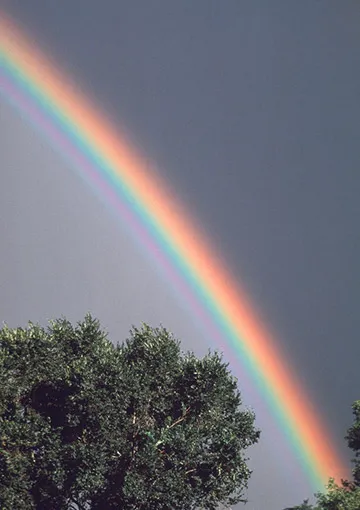Visible Light

Rainbows show how visible light is a combination of many colors.
UCAR
Visible light is one way energy moves around. Light waves are the result of vibrations of electric and magnetic fields, and are thus a form of electromagnetic (EM) radiation. Visible light is just one of many types of EM radiation, and occupies a very small range of the overall electromagnetic spectrum but because we can see light with our eyes, it has special significance to us.
Light waves have wavelengths between about 400 and 700 nanometers (4,000 to 7,000 angstroms). Our eyes perceive different wavelengths of light as the rainbow hues of colors. Red light has relatively long waves, around 700 nm long. Blue and purple light have short waves, around 400 nm. Shorter waves vibrate at higher frequencies and have higher energies. Red light has a frequency around 430 terahertz, while blue's frequency is closer to 750 terahertz. Red photons of light carry about 1.8 electron volts (eV) of energy, while each blue photon transmits about 3.1 eV.
Visible light's neighbors on the EM spectrum are infrared radiation on the one side and ultraviolet radiation on the other. Infrared radiation has longer waves than red light, and thus oscillates at a lower frequency and carries less energy. Ultraviolet radiation has shorter waves than blue or violet light, and thus oscillates more rapidly and carries more energy per photon than visible light does.
Light travels at a speed of 299,792 kilometers per second (about 186,282 miles per second). At this speed, light could circle Earth more than seven times in one second! The lowercase letter "c" is often used to represent the speed of light in equations, such as Einstein's famous relation between energy and matter: E = mc2. All forms of electromagnetic waves, including X-rays and radio waves and all other frequencies across the EM spectrum, also travel at the speed of light. Light travels most rapidly in a vacuum, and moves slightly slower in materials like water or glass.
When light passes from one material to another material with a different density, is usually bends or changes course. Different colors of light bend by slightly different amounts. When blue light passes from air through a dense glass prism, for example, it bends slightly more than red light does. This is why a prism breaks white light up into a rainbow of different colors. Raindrops can become natural prisms, causing rainbows when sunlight passes through.
© 2018 UCAR with portions adapted from Windows to the Universe (© 2005 NESTA)